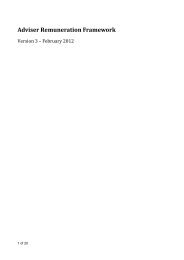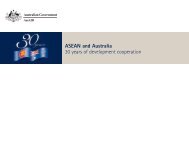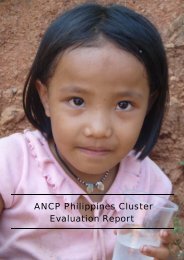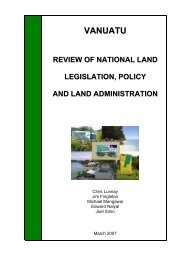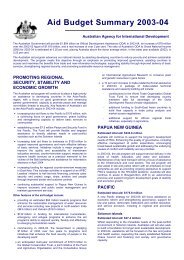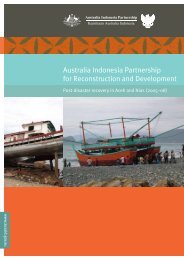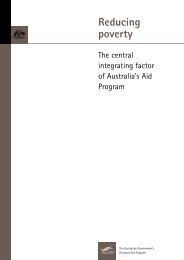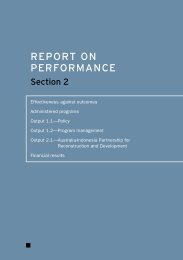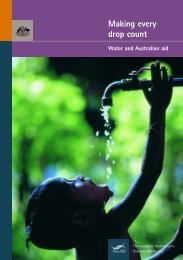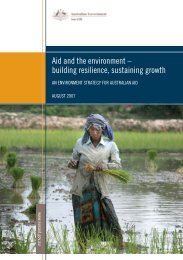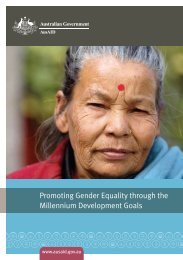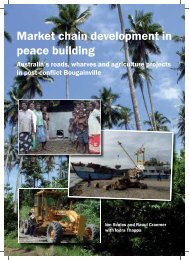Australian Aid to PNG - AusAID
Australian Aid to PNG - AusAID
Australian Aid to PNG - AusAID
Create successful ePaper yourself
Turn your PDF publications into a flip-book with our unique Google optimized e-Paper software.
economy, and any productivity gains arising from improved human or physicalcapital, will also tend <strong>to</strong> keep income higher than it otherwise would be.But <strong>Australian</strong> aid has also had a negative effect on income levels because itcontributed <strong>to</strong> a ‘dutch disease’ type effect by supporting a higher realexchange rate than in the absence of the aid (see Box 3.1). This in turn has hadadverse competitiveness and income effects for agriculture in particular.Recognition of this problem was one of the fac<strong>to</strong>rs motivating the shift frombudget <strong>to</strong> program support. The full cost of this ‘dutch disease’ effect is unclear,in part because the economy is still adjusting <strong>to</strong> the removal of the imbalancesthat were created.This means it cannot be said whether the positives offered by <strong>Australian</strong> aid forincome levels and growth did outweigh the negatives. What is clear is thataction has been taken <strong>to</strong> reduce the negative effect on growth in the future.BOX 3.1 THE DUTCH DISEASE IN PAPUA NEW GUINEAInternationally the ‘dutch disease’ problem is normally faced when large exportrevenue from enclave-type resource projects raise the demand for local currency andleads <strong>to</strong> a higher exchange rate than would otherwise be the case (this can see thereal exchange rate appreciate relative <strong>to</strong> what it would otherwise be). This is aproblem because it reduces the international competitiveness of other sec<strong>to</strong>rs,normally export-focused agricultural activities and import-competing activities suchas local food production. The result is that enclave-type resource projects canindirectly take place at the expense of other forms of activity.In the Papua New Guinea context, much of the export revenue from the mining andoil sec<strong>to</strong>rs remains permanently offshore and does not flow through the foreignexchange market. But the payment of taxes and, <strong>to</strong> a lesser extent, local costsprovides a large inflow of foreign exchange. This has had the effect of lifting thedemand for kina in the foreign exchange market (as the Government etc seeks <strong>to</strong> sellits foreign exchange) and combined with other fac<strong>to</strong>rs leading <strong>to</strong> a higher real valueof the kina than would otherwise have applied.In Papua New Guinea the inflow of revenue from the mining and oil sec<strong>to</strong>rs has alsobeen supplemented by a large inflow of donor funds from the international donorcommunity, notably the budget support of Australia. This inflow of foreign exchange hasadded <strong>to</strong> the dutch disease problem by also providing support for the exchange rate. 33 See <strong>AusAID</strong> (1999), Duncan et. al. (1998), Fallon et.al. (1995) and King and Sugden (1996) for recentdiscussion of the dutch disease problem in Papua New Guinea. The problem has been acknowledged for atleast 20 years, with Garnaut and Baxter (1984), Jarrett and Anderson (1989) and Goodman, Lepani andMorawetz (1987) providing good discussion of early thinking on the issue.22 The Contribution of <strong>Australian</strong> <strong>Aid</strong> <strong>to</strong> Papua New Guinea’s Development 1975–2000



